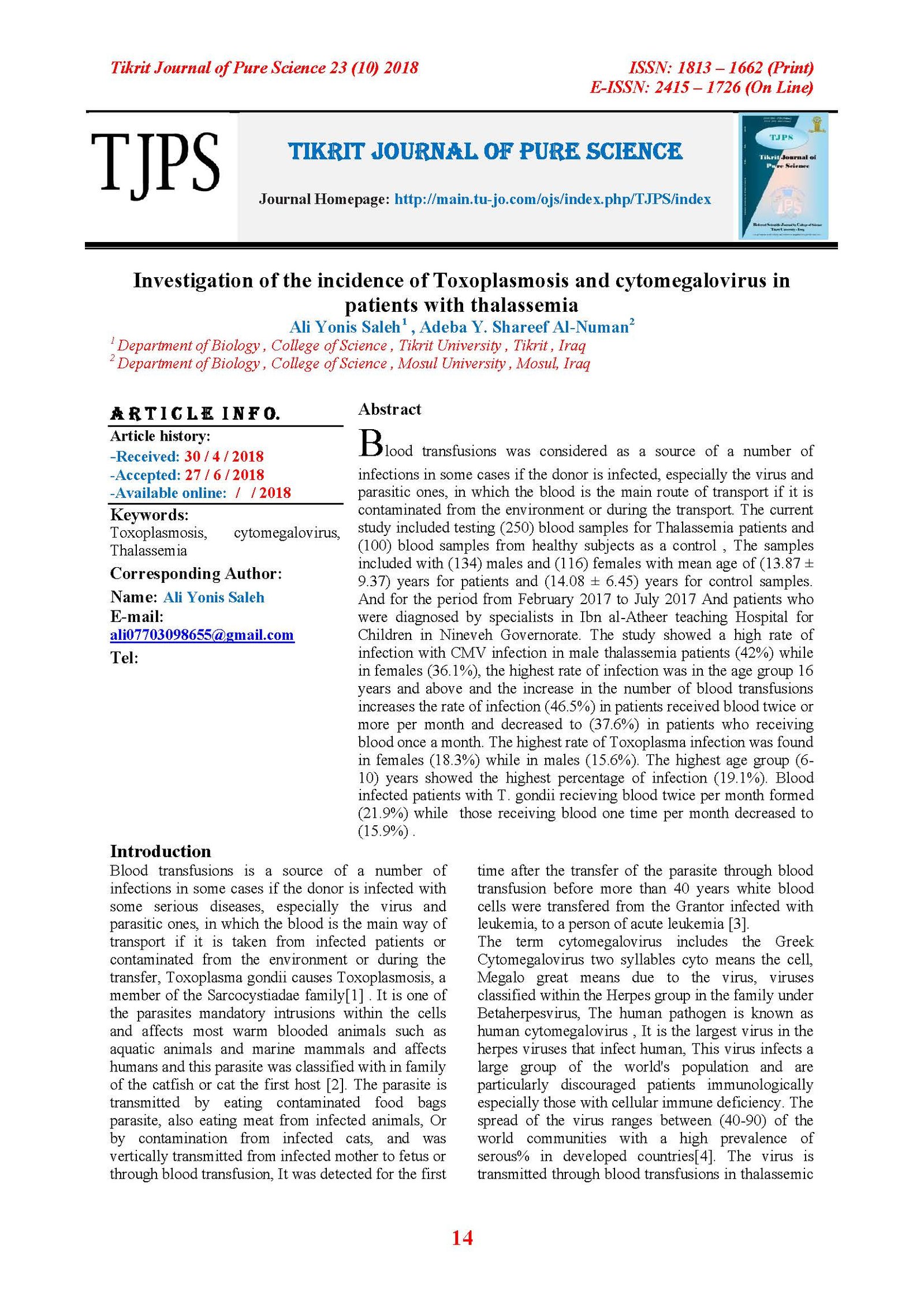Investigation of the incidence of Toxoplasmosis and cytomegalovirus in patients with thalassemia
Main Article Content
Abstract
Blood transfusions was considered as a source of a number of infections in some cases if the donor is infected, especially the virus and parasitic ones, in which the blood is the main route of transport if it is contaminated from the environment or during the transport. The current study included testing (250) blood samples for Thalassemia patients and (100) blood samples from healthy subjects as a control , The samples included with (134) males and (116) females with mean age of (13.87 ± 9.37) years for patients and (14.08 ± 6.45) years for control samples. And for the period from February 2017 to July 2017 And patients who were diagnosed by specialists in Ibn al-Atheer teaching Hospital for Children in Nineveh Governorate. The study showed a high rate of infection with CMV infection in male thalassemia patients (42%) while in females (36.1%), the highest rate of infection was in the age group 16 years and above and the increase in the number of blood transfusions increases the rate of infection (46.5%) in patients received blood twice or more per month and decreased to (37.6%) in patients who receiving blood once a month. The highest rate of Toxoplasma infection was found in females (18.3%) while in males (15.6%). The highest age group (6-10) years showed the highest percentage of infection (19.1%). Blood infected patients with T. gondii recieving blood twice per month formed (21.9%) while those receiving blood one time per month decreased to (15.9%) .
Article Details

This work is licensed under a Creative Commons Attribution 4.0 International License.
Tikrit Journal of Pure Science is licensed under the Creative Commons Attribution 4.0 International License, which allows users to copy, create extracts, abstracts, and new works from the article, alter and revise the article, and make commercial use of the article (including reuse and/or resale of the article by commercial entities), provided the user gives appropriate credit (with a link to the formal publication through the relevant DOI), provides a link to the license, indicates if changes were made, and the licensor is not represented as endorsing the use made of the work. The authors hold the copyright for their published work on the Tikrit J. Pure Sci. website, while Tikrit J. Pure Sci. is responsible for appreciate citation of their work, which is released under CC-BY-4.0, enabling the unrestricted use, distribution, and reproduction of an article in any medium, provided that the original work is properly cited.
References
[1] Flegr, J. ; Prandota, J.; Sovičková, M.; and Israili, Z. H. (2014). Toxoplasmosis–a global threat. Correlation of latent toxoplasmosis with specific disease burden in a set of 88 countries. PloS one, 9(3), e90203.
[2] Robert-Gangneux, F.; and Dardé, M. L. (2012). Epidemiology of and diagnostic strategies for toxoplasmosis. Clinical microbiology reviews, 25(2), 264-296.
[3] Pinlaor, S.; Ieamviteevanich, K.; Pinlaor, P.; Maleewong, W., and Pipitgool, V. (2000). Seroprevalence of specific total immunoglobulin (Ig), IgG and IgM antibodies to Toxoplasma gondii in blood donors from Loei Province, Northeast Thailand.
[4] Cannon, M. J.; Schmid, D. S. and Hyde, T. B. (2010). Review of cytomegalovirus seroprevalence and demographic characteristics associated with infection. Reviews in medical virology, 20(4), 202-213.
[5] Goodrum, F. (2016). Human cytomegalovirus latency: approaching the Gordian knot. Annual review of virology, 3, 333-357.
[6] Daryani, A.; Sarvi, S.; Aarabi, M.; Mizani, A.; Ahmadpour, E.; Shokri, A.; .. and Sharif, M. (2014). Seroprevalence of Toxoplasma gondii in the Iranian general population: a systematic review and meta-analysis. Acta tropica, 137, 185-194.
[7] Channon, J. Y.; Seguin, R. M.; and Kasper, L. H. (2000). Differential Infectivity and Division of Toxoplasma gondii in Human Peripheral Blood Leukocytes. Infection and immunity, 68(8), 4822-4826.
[8] Neva FA, Brown HW(1994). Basic clinical parasitology, 6th ed. East Norwalk, CT: Appleton and Lange.
[9] de Matos, S. B., Meyer, R., & Lima, F. W. D. M. (2011). Seroprevalence and serum profile of cytomegalovirus infection among patients with hematologic disorders in Bahia State, Brazil. Journal of medical virology, 83(2), 298-304.
[10] Jayarama, V.; Marcello, J.; Ohagen, A.; Gibaja, V.; Lunderville, D.; Horrigan, J., .and Lazo, A. (2006). Development of models and detection methods for different forms of cytomegalovirus for the evaluation of viral inactivation agents. Transfusion, 46(9), 1580-1588.
